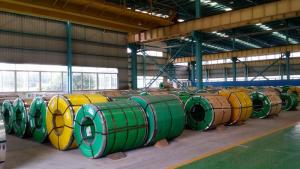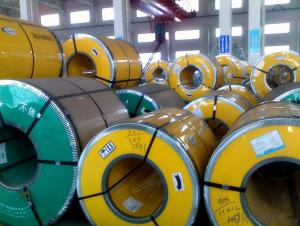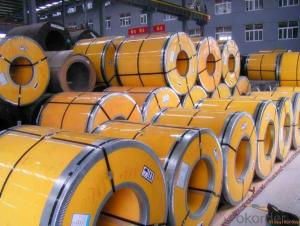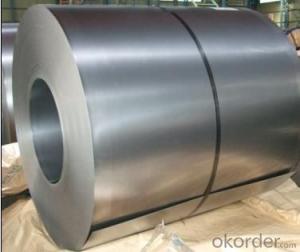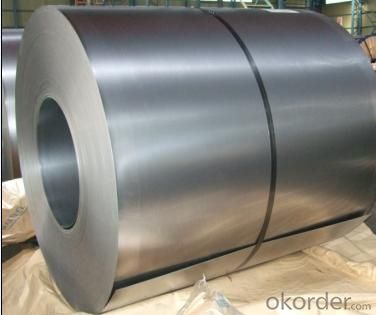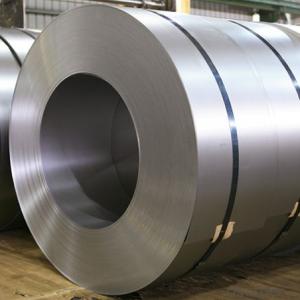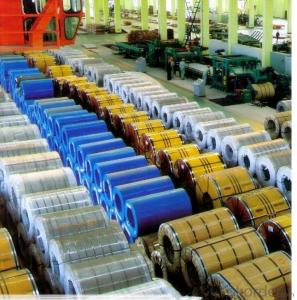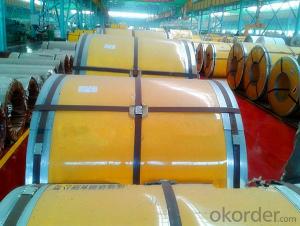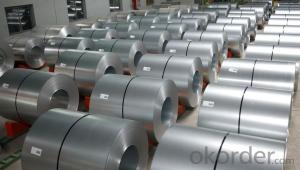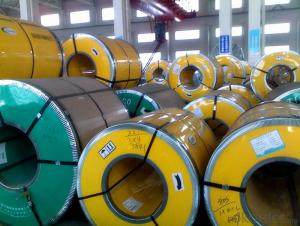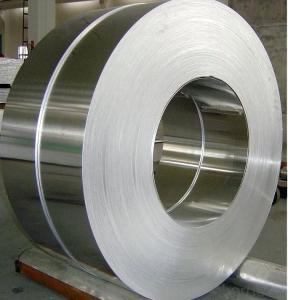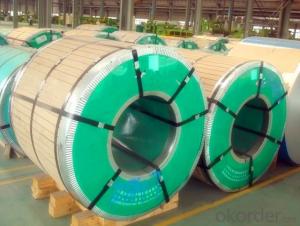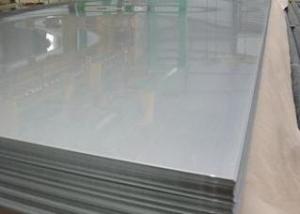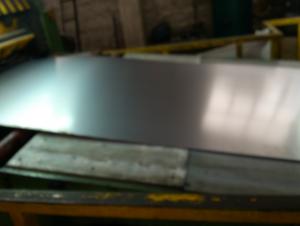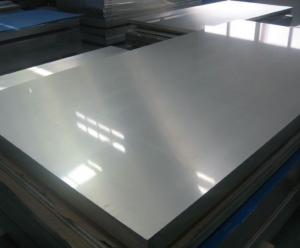Cold Rolled Stainless Steel Coil 304 Grade 2B Finish
- Loading Port:
- China Main Port
- Payment Terms:
- TT OR LC
- Min Order Qty:
- -
- Supply Capability:
- -
OKorder Service Pledge
OKorder Financial Service
You Might Also Like
Cold Rolled Stainless Steel Coil 304 Grade 2B Finish
Packaging Detail:standard export packing or as customer's requirements
Delivery Detail:7-15 days after the order
MOQ: 25mt
Standard: | AISI,ASTM,BS,DIN,GB,JIS | Grade: | 304 | Thickness: | 0.3-3.0mm |
Place of Origin: | China Mainland | Brand Name: | CNBM | Model Number: | 304 |
Type: | Steel Coil | Technique: | Cold Rolled | Surface Treatment: | 2B, BA |
Application: | Medical instruments, building, chemical food industry agriculture | Width: | 500-2000mm | Length: | Coil |
finish: | 2B | item: | 304 cold rolled stainless steel coil | density: | 7.93 |
Cold Rolled Stainless Steel Coil 304 Grade 2B Finish
Chemical composition: |
| ||||||
C | Si | Mn | Cr | Ni | S | P | |
≤0.07 | ≤1.0 | ≤2.0 | 18.0~20.0 | 8.0~11.0 | ≤0.03 | ≤0.035 | |
mechanical properties: |
| ||||||
Tensile strength σb (MPa) | Conditions yield strength 0.2 sigma (MPa) | Elongation δ5 (%) | Section shrinkage (%) | Hardness | |||
520 | 205 | 40 | 60 | ≤1 | |||
- Q: What are the different types of surface treatments available for stainless steel strips?
- The stainless steel strips offer various surface treatments, each with unique advantages and applications. Some commonly used treatments are: 1. Polishing: By mechanically smoothing the surface, polishing creates a glossy finish. It not only improves the appearance but also enhances corrosion resistance and simplifies cleaning. 2. Brushing: This treatment involves rubbing the strip with an abrasive material to create a brushed texture. It hides scratches and fingerprints, making it suitable for achieving a matte or satin finish. 3. Passivation: By chemically removing iron contaminants, passivation enhances the steel's corrosion resistance. It involves immersing the strip in an acid solution to eliminate impurities and create a protective oxide layer. 4. Electropolishing: Similar to polishing, electropolishing is an electrochemical process that removes a thin layer of material. It smooths the surface, reduces roughness, and improves cleanliness and corrosion resistance. 5. PVD Coating: Physical Vapor Deposition (PVD) coating deposits a thin layer of material onto the strip's surface. This treatment offers decorative and functional coatings like gold or colored finishes, as well as enhanced hardness or wear resistance. 6. Chemical Etching: By selectively removing material, chemical etching creates intricate designs or patterns. It is commonly used for branding or decorative purposes. 7. Powder Coating: In this treatment, a dry powder is applied and heated to form a protective layer. Powder coating provides excellent corrosion resistance, durability, and can be customized with different colors or textures. To select the appropriate surface treatment, it is crucial to consider the specific requirements and intended use of the stainless steel strip. Each treatment offers different properties and finishes that can enhance the overall performance and appearance of the steel.
- Q: How do stainless steel strips perform in low temperature environments?
- Stainless steel strips perform exceptionally well in low temperature environments due to their inherent properties such as high strength, corrosion resistance, and toughness. They are capable of maintaining their structural integrity, durability, and resistance to brittleness even in extremely cold temperatures.
- Q: What are the common applications for stainless steel strips?
- Stainless steel strips have various common applications across different industries. Some of the common uses include automotive components, construction materials, kitchen appliances, electrical enclosures, and decorative trim. They are also utilized in the manufacturing of medical instruments, equipment for food processing, and aerospace components. The corrosion resistance, durability, and aesthetic appeal of stainless steel make it a versatile material for a wide range of applications.
- Q: Can stainless steel strips be used in food processing equipment?
- Yes, stainless steel strips can be used in food processing equipment. Stainless steel is a popular choice in the food industry due to its many desirable properties. It is highly resistant to corrosion, which is crucial in an environment where contact with food and water is common. Stainless steel is also easy to clean and sanitize, making it suitable for food processing equipment that requires frequent washing. Additionally, stainless steel is non-reactive with food, meaning it will not leach any harmful substances into the products being processed. It is also durable and strong, ensuring that the equipment will withstand the demands of the food processing industry. Overall, stainless steel strips are a reliable and safe option for use in food processing equipment.
- Q: Can stainless steel strips be used in food processing applications?
- Yes, stainless steel strips can be used in food processing applications. Stainless steel is an ideal material for the food industry due to its superior corrosion resistance, durability, and hygiene properties. It is resistant to rust, staining, and chemical reactions, making it suitable for contact with various food products. Stainless steel strips are commonly used in food processing equipment such as conveyors, mixers, tanks, and cutting tools. Additionally, stainless steel is easy to clean and maintain, ensuring the highest standards of food safety and preventing contamination.
- Q: Are 111 stainless steel strips resistant to pitting and crevice corrosion?
- Yes, 111 stainless steel strips are resistant to pitting and crevice corrosion. Stainless steel grade 111, also known as AISI 111, is a high-performance austenitic stainless steel alloy that contains a high level of chromium, which provides excellent corrosion resistance. The addition of molybdenum further enhances its resistance to pitting and crevice corrosion, making it suitable for various applications where these types of corrosion are a concern. Therefore, 111 stainless steel strips are a reliable choice when corrosion resistance is required.
- Q: What are the different types of stainless steel strips available?
- There are several different types of stainless steel strips available, each with their own unique properties and applications. 1. Austenitic Stainless Steel Strips: This type of stainless steel is the most common and widely used. It has excellent corrosion resistance, good formability, and high ductility. Austenitic stainless steel strips are often used in food processing, chemical, and pharmaceutical industries. 2. Ferritic Stainless Steel Strips: Ferritic stainless steel strips have high resistance to corrosion, but lower ductility and formability compared to austenitic stainless steel. They are commonly used in automotive applications, as well as in appliances and exhaust systems. 3. Martensitic Stainless Steel Strips: Martensitic stainless steel strips are known for their high strength and hardness. They have moderate corrosion resistance and are often used in applications that require wear resistance, such as cutlery, surgical instruments, and industrial equipment. 4. Duplex Stainless Steel Strips: Duplex stainless steel strips combine the best qualities of both austenitic and ferritic stainless steels. They have excellent corrosion resistance, high strength, and good weldability. Duplex stainless steel strips are commonly used in chemical processing, oil and gas industries, and marine environments. 5. Precipitation Hardening Stainless Steel Strips: This type of stainless steel can be hardened through heat treatment, resulting in high strength and excellent corrosion resistance. Precipitation hardening stainless steel strips are used in aerospace applications, as well as in high-performance components and tools. It's important to consider the specific requirements of your application and consult with a stainless steel supplier to determine the best type of stainless steel strip for your needs.
- Q: What are the standard dimensions for stainless steel strips?
- The standard dimensions for stainless steel strips can vary depending on the specific application and industry requirements. However, some common standard dimensions include thicknesses ranging from 0.1mm to 3.0mm, widths ranging from 10mm to 600mm, and lengths ranging from 1000mm to 6000mm. These dimensions are commonly used in various industries such as automotive, construction, and manufacturing. It is important to note that these dimensions can be customized based on the specific needs of a project or application.
- Q: Are stainless steel strips heat resistant?
- Yes, stainless steel strips are heat resistant. They can withstand high temperatures without warping, becoming brittle, or losing their strength.
- Q: Can 111 stainless steel strips be perforated for filtration applications?
- Yes, 111 stainless steel strips can be perforated for filtration applications. Perforating stainless steel strips allows for the creation of fine holes or slots, which are essential for filtration purposes. The size and pattern of the perforations can be customized to meet specific filtration requirements. Stainless steel is often chosen for filtration applications due to its durability, corrosion resistance, and ability to withstand high temperatures. Therefore, utilizing 111 stainless steel strips for perforation can provide an effective solution for various filtration needs.
Send your message to us
Cold Rolled Stainless Steel Coil 304 Grade 2B Finish
- Loading Port:
- China Main Port
- Payment Terms:
- TT OR LC
- Min Order Qty:
- -
- Supply Capability:
- -
OKorder Service Pledge
OKorder Financial Service
Similar products
Hot products
Hot Searches
Related keywords
